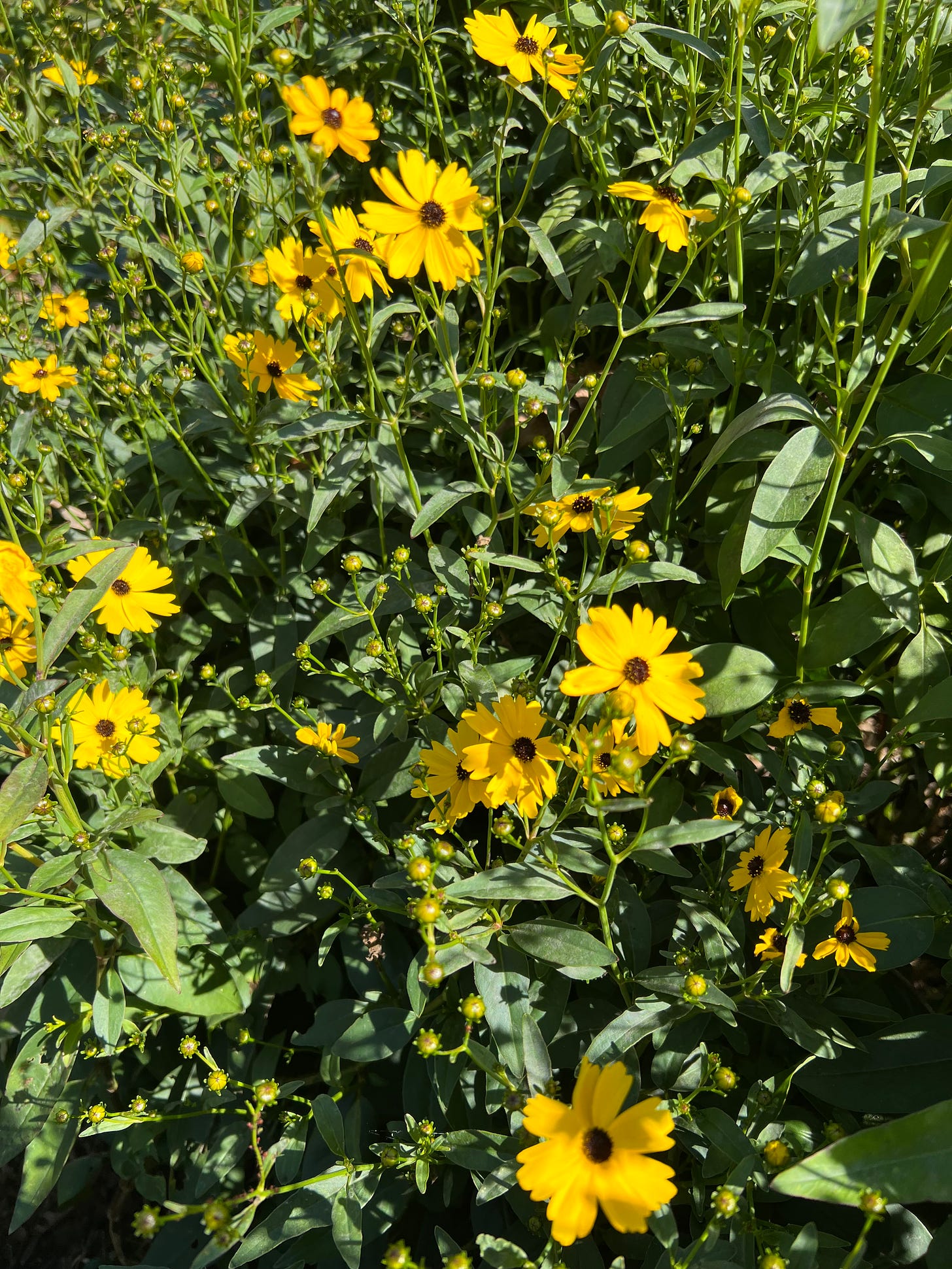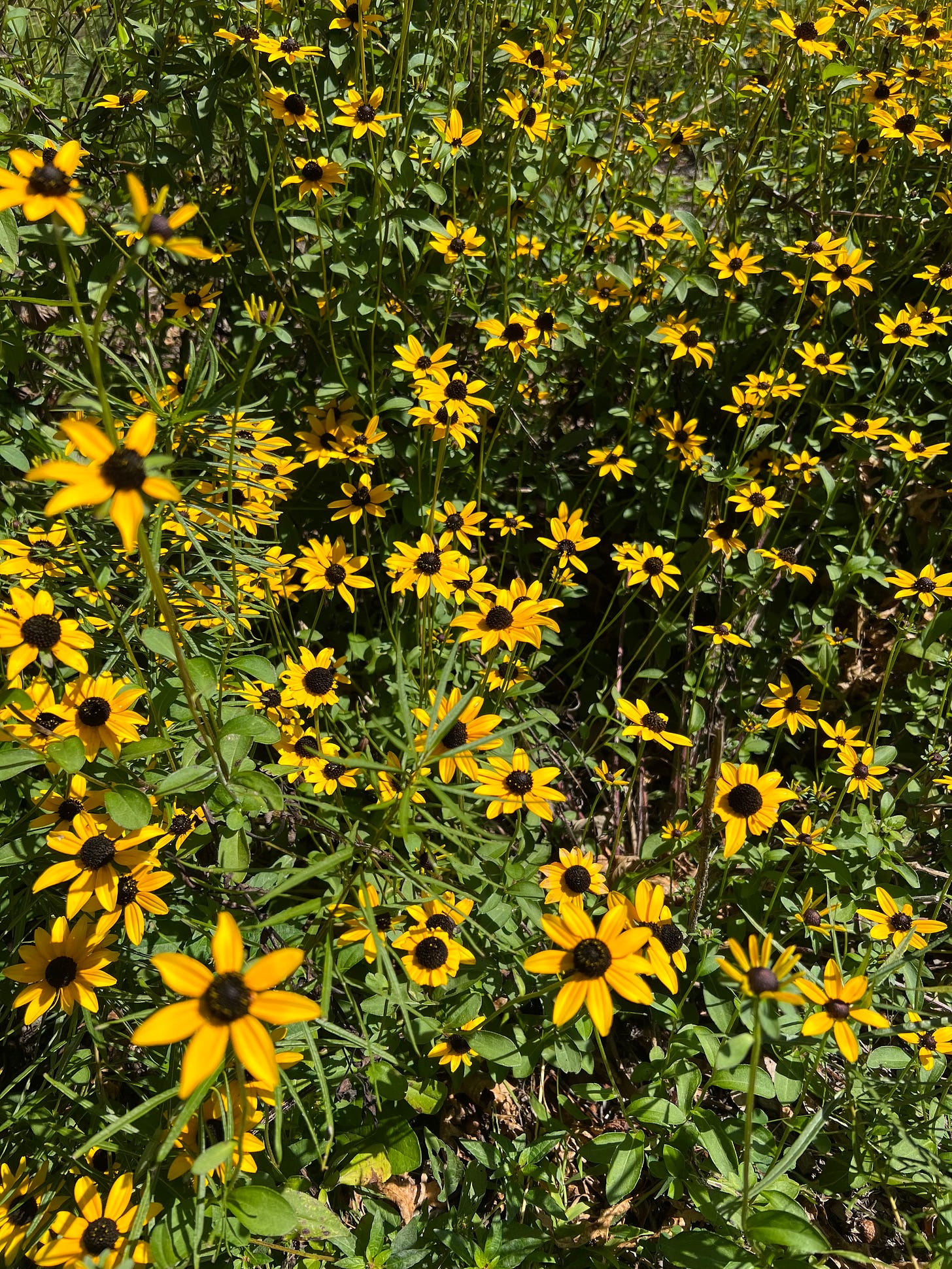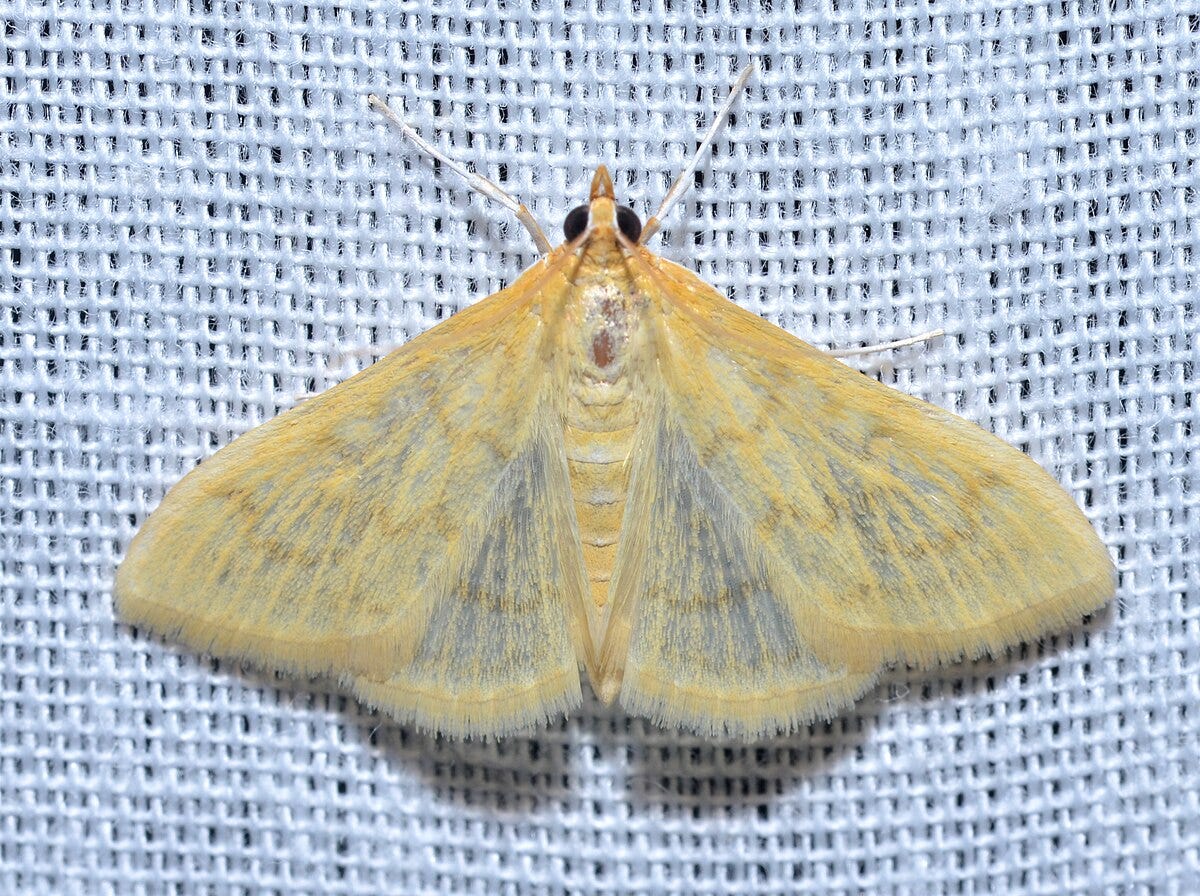September is Golden
Puddock Hill Journal #75: Some goldenrods have been in bloom since August, but in September they really shine.
Everywhere I look is yellow.
In the patio garden, whorled tickseed (Coreopsis verticillata) continues to bloom, even though its show should have ended in July:
Also a bit off schedule, this fringeleaf tickseed (Coreopsis integrifolia ‘Last Dance’), scheduled for October, has already begun to bloom:
Meanwhile, although some of our black-eyed Susan (Rudbeckia hirta) got creamed by the giant red oak that fell mid-summer, that which escaped continues going strong:
But out in the meadows, the brown-eyed Susan (Rudbeckia triloba) that cropped up all over the place this summer has now yielded its leading role to waves of goldenrod.
Here is the latter plant (Solidago spp. all) growing near the base of the hill meadow:
In the barn meadow:
Along the lower path by the big pond:
In the wet meadow:
There are more than 100 species of goldenrod, 75 of which are native to North America and 30 of which are native to Pennsylvania. My plant identification skills are wanting, but I believe Canada goldenrod (Solidago canadensis) and wrinkleleaf goldenrod (Solidago rugosa) constitute the predominant species here at Puddock Hill.
Ecologists consider goldenrods to be a keystone species, meaning they play an important role in sustaining native wildlife. Here’s the summation of wildlife impact of goldenrod from USDA (references omitted):
Goldenrod species are highly valuable late-season wildflowers for pollinators and birds in North America. In the Mid-Atlantic, goldenrods provide food and shelter for migrating monarchs, 11 native bee species, and 115 butterfly and moth species. Honeybees are known to frequent goldenrod in the fall while collecting nectar for overwintering. Beneficial solitary wasps, soldier beetles (Chauliognathus pensylvanicus), and black blister beetles (Epicauta pensylvanica) also rely on the nectar. It is believed that goldenrods, alongside asters, are a preferred floral resource for oligolectic bees. A wide range of insects are attracted to the yellow panicles on goldenrod, with some consumers feeding directly on the leaves and stem. Larval consumers include leaf-beetles, leaf-mining flies, gall flies, and fruit flies. Adult pests include plant bugs, stink bugs, and aphids. Bird species also benefit from the presence of goldenrod. Insectivorous bird populations benefit indirectly from goldenrod because of the number of insects they attract. Other bird species feed directly off goldenrod seeds, such as the indigo bunting (Passerina cyanea), American goldfinch (Spinus tristus), and swamp sparrow (Melospiza georgiana). The greater prairie chicken (Tympanucus cupido) and ruffed grouse (Banasa umbellus) consume the leaves. Meadow voles can consume both the leaves and seeds.
I looked up the word “oligolectic” so you wouldn’t have to. It refers to bees that have a specialized preference for a single family or genus of flowering plants. In other words, goldenrods are very important to certain species of bees!
In our area, according to the National Wildlife Federation, the caterpillars of 126 butterflies and moths use Solidago species as a host plant, including astroid (Cucullia asteroides), brown-hooded owlet (Cucullia convexipennis), Green Leuconycta (Leuconycta diphteroides), and wavy-lined emerald (Synchlora aerata).
Hahncappsia marculenta, Helvibotys helvialis, Algedonia mysippusalis, Beautiful Phaneta (Eucosma formosana), Derelict Eucosma (Pelochrista derelicta), Goldenrod Gall Moth (Gnorimoschema gallaesolidaginis), Goldenrod Leaffolder (Agonopterix pulvipennella), Gnorimoschema jocelynae, Gnorimoschema salinarum, Pelochrista similiana, and Rolandylis fusca exclusively use goldenrod as a host plant. Therefore, if goldenrod disappears, so do these animals.
You will note that many of these unloved species have no common names, but that doesn’t mean they aren’t threads in the fabric of life. Here is a photo (via Wikipedia) of Hahncappsia marculenta.
Tell me this little guy with an 18-26 mm wingspan doesn’t have as much right to live as we do.
Those who have planted goldenrod in garden beds will likely report that they are aggressive spreaders. Naturalists, however, might describe this behavior as the ability to suppress invasive plant species.
Goldenrods also support conservation biological control, which is a fancy way of saying they attract predatory or parasitic arthropods that prey upon pest insects.
The creatures that were shy all spring and summer are now feverish and drunk with nectar, preparing for hibernation. When I walked around taking pictures for this newsletter, a variety of voracious individuals covered the goldenrod flowers, whether in shade or sun. There were honeybees, bumblebees, carpenter bees, sweat bees, and several varieties of wasps, in addition to skippers and other insects.
I have been contemplating changing the mow scheme next year to combat invasives better. The prevalence of all this life on the goldenrods today reminds me to be careful next spring.
Nature is always out there, even before the golden hues of September scream for our attention.
Tall goldenrod (Solidago altissima presumably) crests the springhouse roof line:
A native northern paper wasp (Polistes fuscatus) feeds on goldenrod:
A native eastern carpenter bee (Xylocopa virginica) feasts on goldenrod:
Of course, it’s not really ALL yellow out there. Native snakeroot (Ageratina spp.) flowers beside the big pond:















Oh how I miss black eyed Susans! Thanks for the lovely post.